Health Science: Impact of Physical Activity on Obesity and Health
VerifiedAdded on 2023/06/11
|7
|1573
|394
Report
AI Summary
This health science report addresses the prevalence of obesity and overweight issues and their devastating health consequences, primarily driven by physical inactivity. The report emphasizes the need for healthcare departments and stakeholders to reduce overweightness to mitigate risks like cardiovascular diseases, high blood pressure, and diabetes. It advocates for consistent physical activity as a key weight loss strategy, highlighting the importance of creating a calorie deficit through exercise. Various assessment methods, including report-based measures like physical activity questionnaires and monitor-based measures like activity monitors, are discussed for evaluating weight loss practices. The report reflects on scientific research supporting the impact of physical activity on health outcomes, independent of body weight, and recommends incorporating aerobic exercises into workout programs for effective weight management. The conclusion reiterates the significance of combating overweightness through regular physical activity to prevent associated diseases.
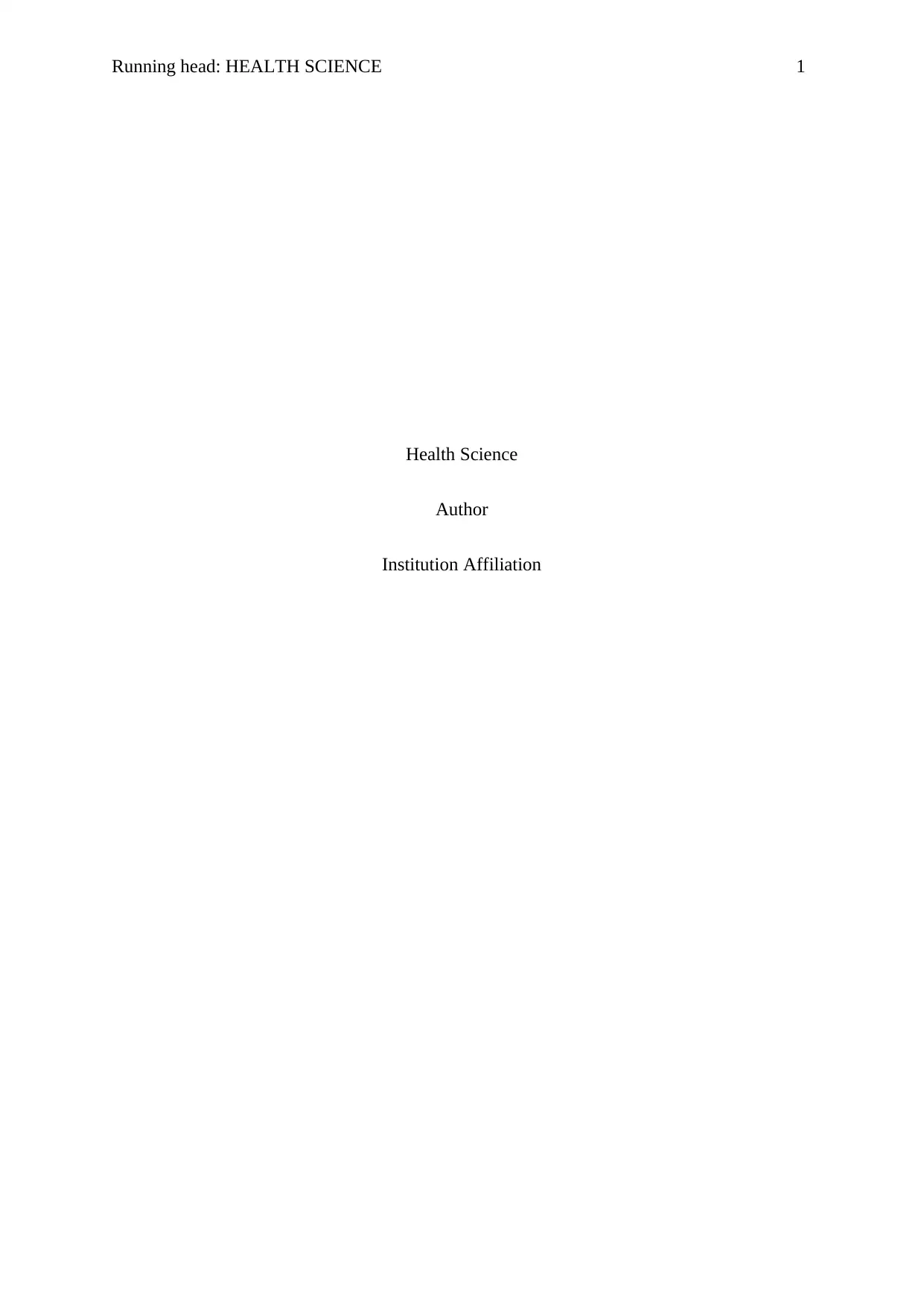
Running head: HEALTH SCIENCE 1
Health Science
Author
Institution Affiliation
Health Science
Author
Institution Affiliation
Paraphrase This Document
Need a fresh take? Get an instant paraphrase of this document with our AI Paraphraser
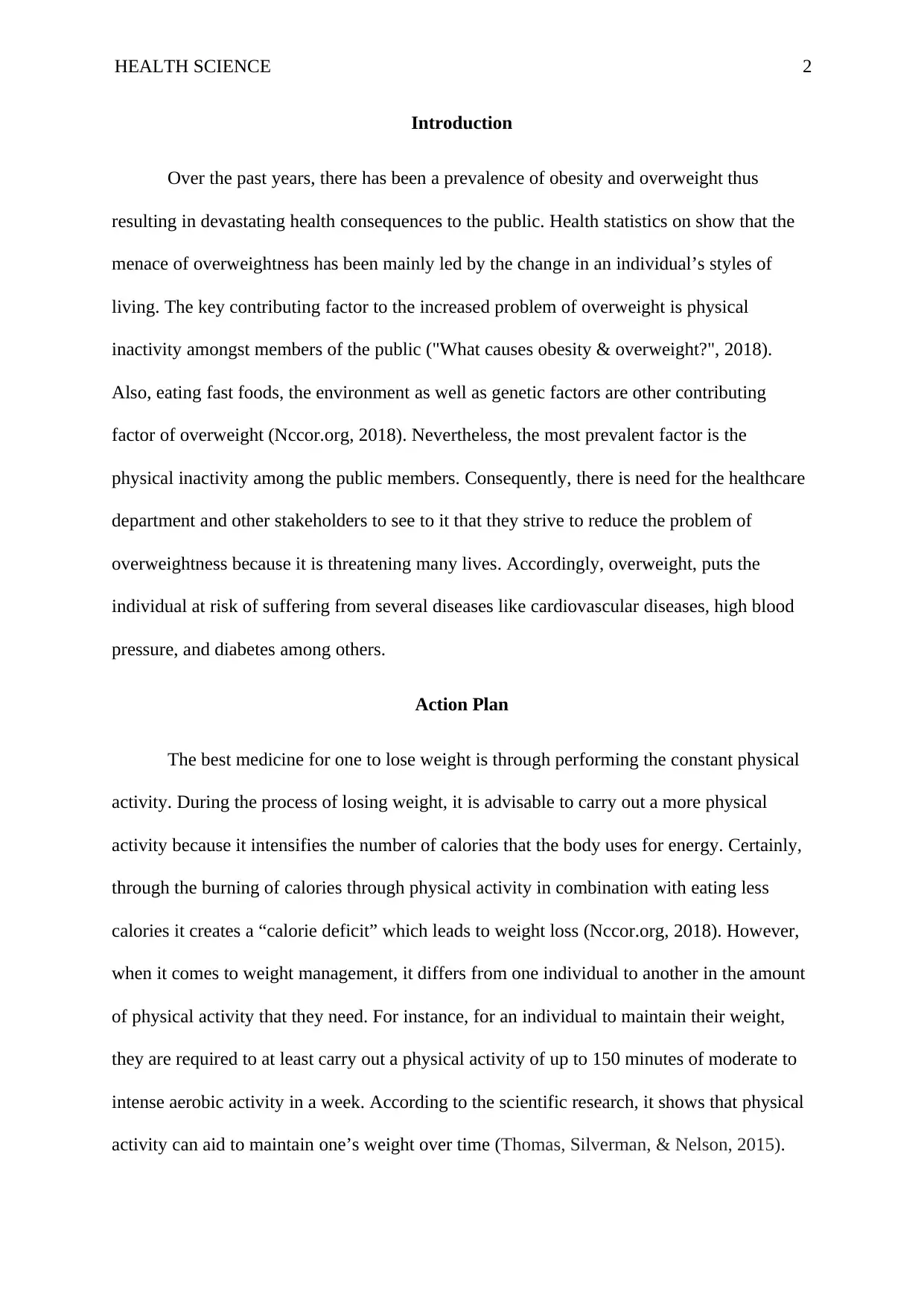
HEALTH SCIENCE 2
Introduction
Over the past years, there has been a prevalence of obesity and overweight thus
resulting in devastating health consequences to the public. Health statistics on show that the
menace of overweightness has been mainly led by the change in an individual’s styles of
living. The key contributing factor to the increased problem of overweight is physical
inactivity amongst members of the public ("What causes obesity & overweight?", 2018).
Also, eating fast foods, the environment as well as genetic factors are other contributing
factor of overweight (Nccor.org, 2018). Nevertheless, the most prevalent factor is the
physical inactivity among the public members. Consequently, there is need for the healthcare
department and other stakeholders to see to it that they strive to reduce the problem of
overweightness because it is threatening many lives. Accordingly, overweight, puts the
individual at risk of suffering from several diseases like cardiovascular diseases, high blood
pressure, and diabetes among others.
Action Plan
The best medicine for one to lose weight is through performing the constant physical
activity. During the process of losing weight, it is advisable to carry out a more physical
activity because it intensifies the number of calories that the body uses for energy. Certainly,
through the burning of calories through physical activity in combination with eating less
calories it creates a “calorie deficit” which leads to weight loss (Nccor.org, 2018). However,
when it comes to weight management, it differs from one individual to another in the amount
of physical activity that they need. For instance, for an individual to maintain their weight,
they are required to at least carry out a physical activity of up to 150 minutes of moderate to
intense aerobic activity in a week. According to the scientific research, it shows that physical
activity can aid to maintain one’s weight over time (Thomas, Silverman, & Nelson, 2015).
Introduction
Over the past years, there has been a prevalence of obesity and overweight thus
resulting in devastating health consequences to the public. Health statistics on show that the
menace of overweightness has been mainly led by the change in an individual’s styles of
living. The key contributing factor to the increased problem of overweight is physical
inactivity amongst members of the public ("What causes obesity & overweight?", 2018).
Also, eating fast foods, the environment as well as genetic factors are other contributing
factor of overweight (Nccor.org, 2018). Nevertheless, the most prevalent factor is the
physical inactivity among the public members. Consequently, there is need for the healthcare
department and other stakeholders to see to it that they strive to reduce the problem of
overweightness because it is threatening many lives. Accordingly, overweight, puts the
individual at risk of suffering from several diseases like cardiovascular diseases, high blood
pressure, and diabetes among others.
Action Plan
The best medicine for one to lose weight is through performing the constant physical
activity. During the process of losing weight, it is advisable to carry out a more physical
activity because it intensifies the number of calories that the body uses for energy. Certainly,
through the burning of calories through physical activity in combination with eating less
calories it creates a “calorie deficit” which leads to weight loss (Nccor.org, 2018). However,
when it comes to weight management, it differs from one individual to another in the amount
of physical activity that they need. For instance, for an individual to maintain their weight,
they are required to at least carry out a physical activity of up to 150 minutes of moderate to
intense aerobic activity in a week. According to the scientific research, it shows that physical
activity can aid to maintain one’s weight over time (Thomas, Silverman, & Nelson, 2015).
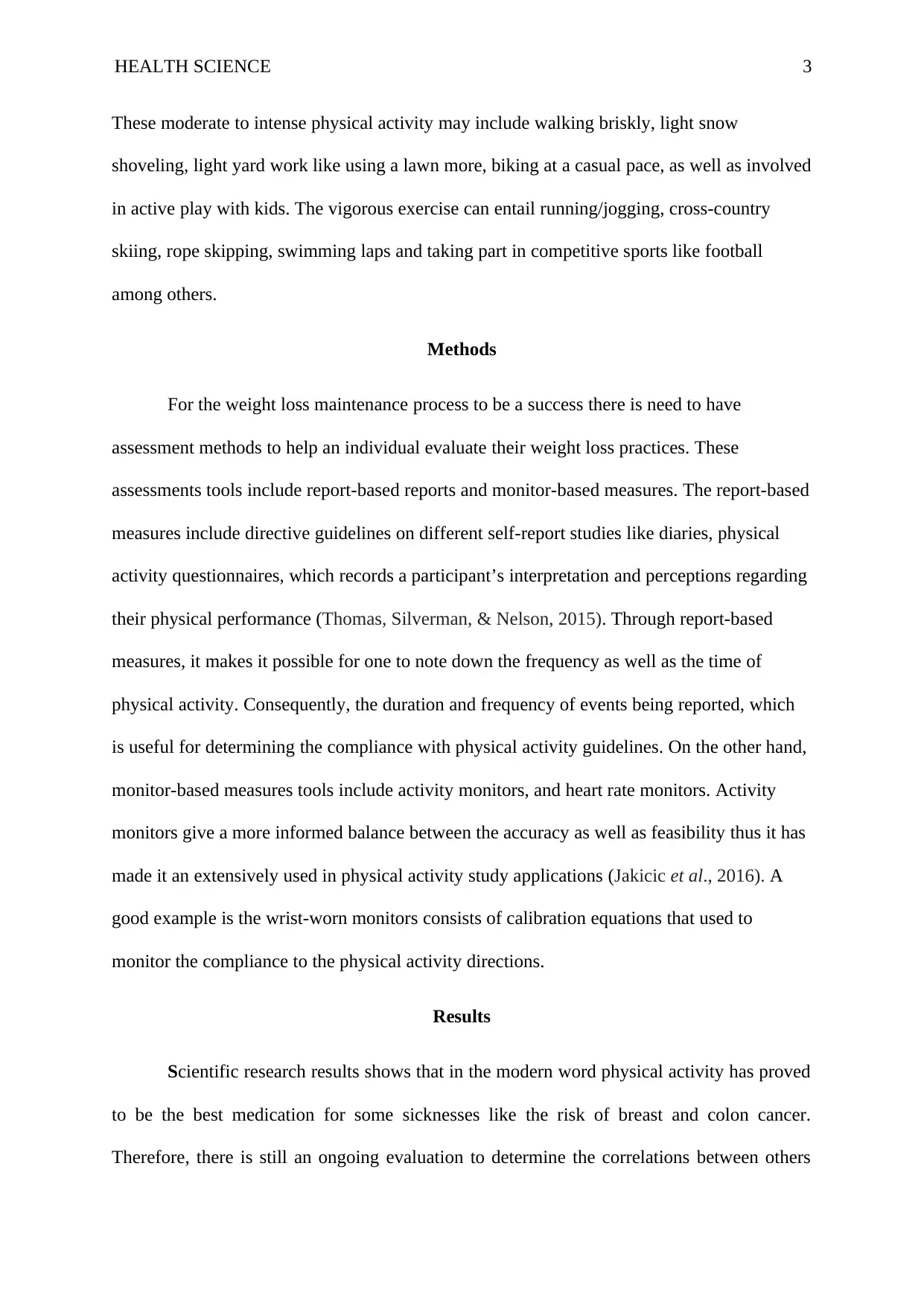
HEALTH SCIENCE 3
These moderate to intense physical activity may include walking briskly, light snow
shoveling, light yard work like using a lawn more, biking at a casual pace, as well as involved
in active play with kids. The vigorous exercise can entail running/jogging, cross-country
skiing, rope skipping, swimming laps and taking part in competitive sports like football
among others.
Methods
For the weight loss maintenance process to be a success there is need to have
assessment methods to help an individual evaluate their weight loss practices. These
assessments tools include report-based reports and monitor-based measures. The report-based
measures include directive guidelines on different self-report studies like diaries, physical
activity questionnaires, which records a participant’s interpretation and perceptions regarding
their physical performance (Thomas, Silverman, & Nelson, 2015). Through report-based
measures, it makes it possible for one to note down the frequency as well as the time of
physical activity. Consequently, the duration and frequency of events being reported, which
is useful for determining the compliance with physical activity guidelines. On the other hand,
monitor-based measures tools include activity monitors, and heart rate monitors. Activity
monitors give a more informed balance between the accuracy as well as feasibility thus it has
made it an extensively used in physical activity study applications (Jakicic et al., 2016). A
good example is the wrist-worn monitors consists of calibration equations that used to
monitor the compliance to the physical activity directions.
Results
Scientific research results shows that in the modern word physical activity has proved
to be the best medication for some sicknesses like the risk of breast and colon cancer.
Therefore, there is still an ongoing evaluation to determine the correlations between others
These moderate to intense physical activity may include walking briskly, light snow
shoveling, light yard work like using a lawn more, biking at a casual pace, as well as involved
in active play with kids. The vigorous exercise can entail running/jogging, cross-country
skiing, rope skipping, swimming laps and taking part in competitive sports like football
among others.
Methods
For the weight loss maintenance process to be a success there is need to have
assessment methods to help an individual evaluate their weight loss practices. These
assessments tools include report-based reports and monitor-based measures. The report-based
measures include directive guidelines on different self-report studies like diaries, physical
activity questionnaires, which records a participant’s interpretation and perceptions regarding
their physical performance (Thomas, Silverman, & Nelson, 2015). Through report-based
measures, it makes it possible for one to note down the frequency as well as the time of
physical activity. Consequently, the duration and frequency of events being reported, which
is useful for determining the compliance with physical activity guidelines. On the other hand,
monitor-based measures tools include activity monitors, and heart rate monitors. Activity
monitors give a more informed balance between the accuracy as well as feasibility thus it has
made it an extensively used in physical activity study applications (Jakicic et al., 2016). A
good example is the wrist-worn monitors consists of calibration equations that used to
monitor the compliance to the physical activity directions.
Results
Scientific research results shows that in the modern word physical activity has proved
to be the best medication for some sicknesses like the risk of breast and colon cancer.
Therefore, there is still an ongoing evaluation to determine the correlations between others
⊘ This is a preview!⊘
Do you want full access?
Subscribe today to unlock all pages.

Trusted by 1+ million students worldwide
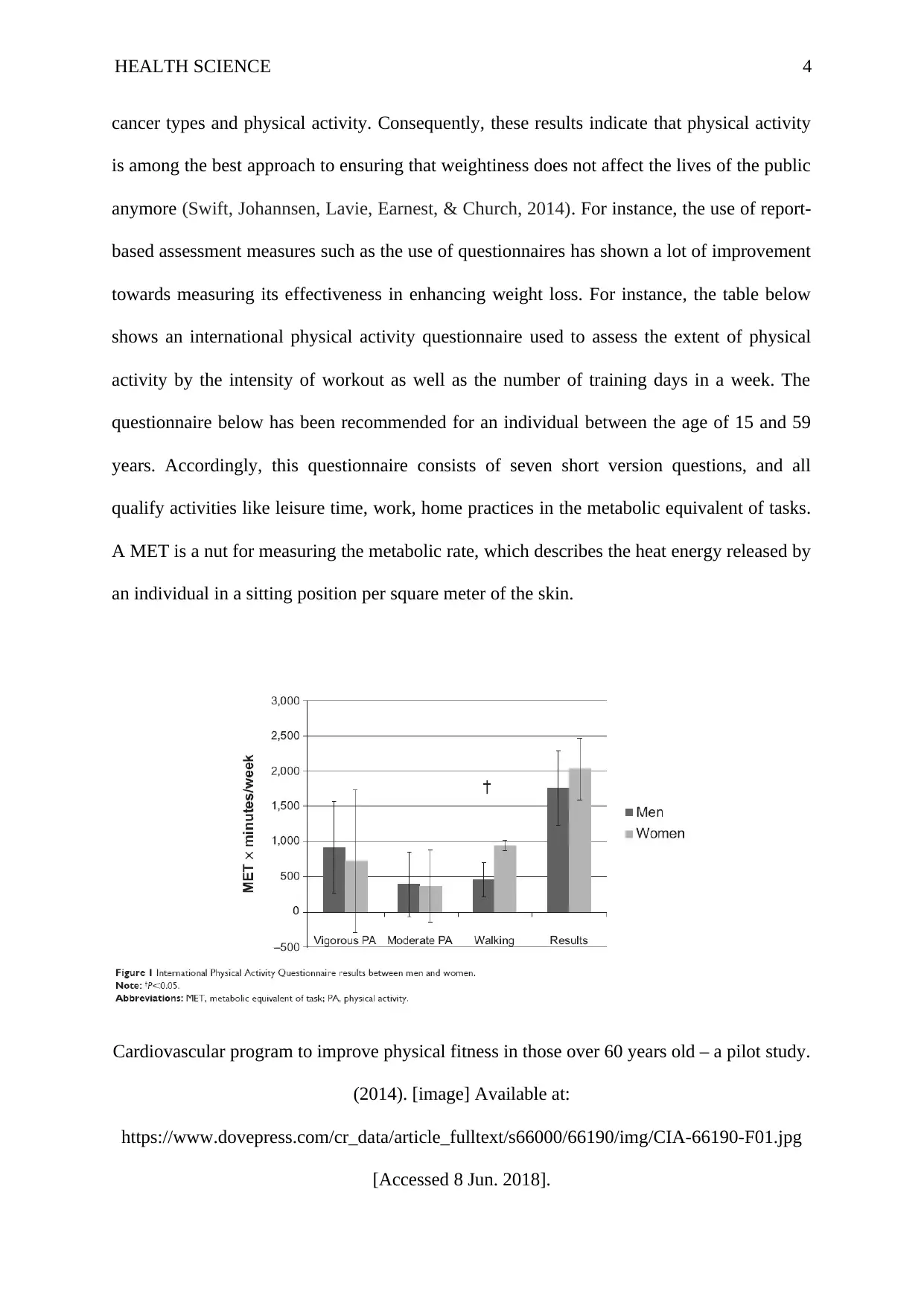
HEALTH SCIENCE 4
cancer types and physical activity. Consequently, these results indicate that physical activity
is among the best approach to ensuring that weightiness does not affect the lives of the public
anymore (Swift, Johannsen, Lavie, Earnest, & Church, 2014). For instance, the use of report-
based assessment measures such as the use of questionnaires has shown a lot of improvement
towards measuring its effectiveness in enhancing weight loss. For instance, the table below
shows an international physical activity questionnaire used to assess the extent of physical
activity by the intensity of workout as well as the number of training days in a week. The
questionnaire below has been recommended for an individual between the age of 15 and 59
years. Accordingly, this questionnaire consists of seven short version questions, and all
qualify activities like leisure time, work, home practices in the metabolic equivalent of tasks.
A MET is a nut for measuring the metabolic rate, which describes the heat energy released by
an individual in a sitting position per square meter of the skin.
Cardiovascular program to improve physical fitness in those over 60 years old – a pilot study.
(2014). [image] Available at:
https://www.dovepress.com/cr_data/article_fulltext/s66000/66190/img/CIA-66190-F01.jpg
[Accessed 8 Jun. 2018].
cancer types and physical activity. Consequently, these results indicate that physical activity
is among the best approach to ensuring that weightiness does not affect the lives of the public
anymore (Swift, Johannsen, Lavie, Earnest, & Church, 2014). For instance, the use of report-
based assessment measures such as the use of questionnaires has shown a lot of improvement
towards measuring its effectiveness in enhancing weight loss. For instance, the table below
shows an international physical activity questionnaire used to assess the extent of physical
activity by the intensity of workout as well as the number of training days in a week. The
questionnaire below has been recommended for an individual between the age of 15 and 59
years. Accordingly, this questionnaire consists of seven short version questions, and all
qualify activities like leisure time, work, home practices in the metabolic equivalent of tasks.
A MET is a nut for measuring the metabolic rate, which describes the heat energy released by
an individual in a sitting position per square meter of the skin.
Cardiovascular program to improve physical fitness in those over 60 years old – a pilot study.
(2014). [image] Available at:
https://www.dovepress.com/cr_data/article_fulltext/s66000/66190/img/CIA-66190-F01.jpg
[Accessed 8 Jun. 2018].
Paraphrase This Document
Need a fresh take? Get an instant paraphrase of this document with our AI Paraphraser
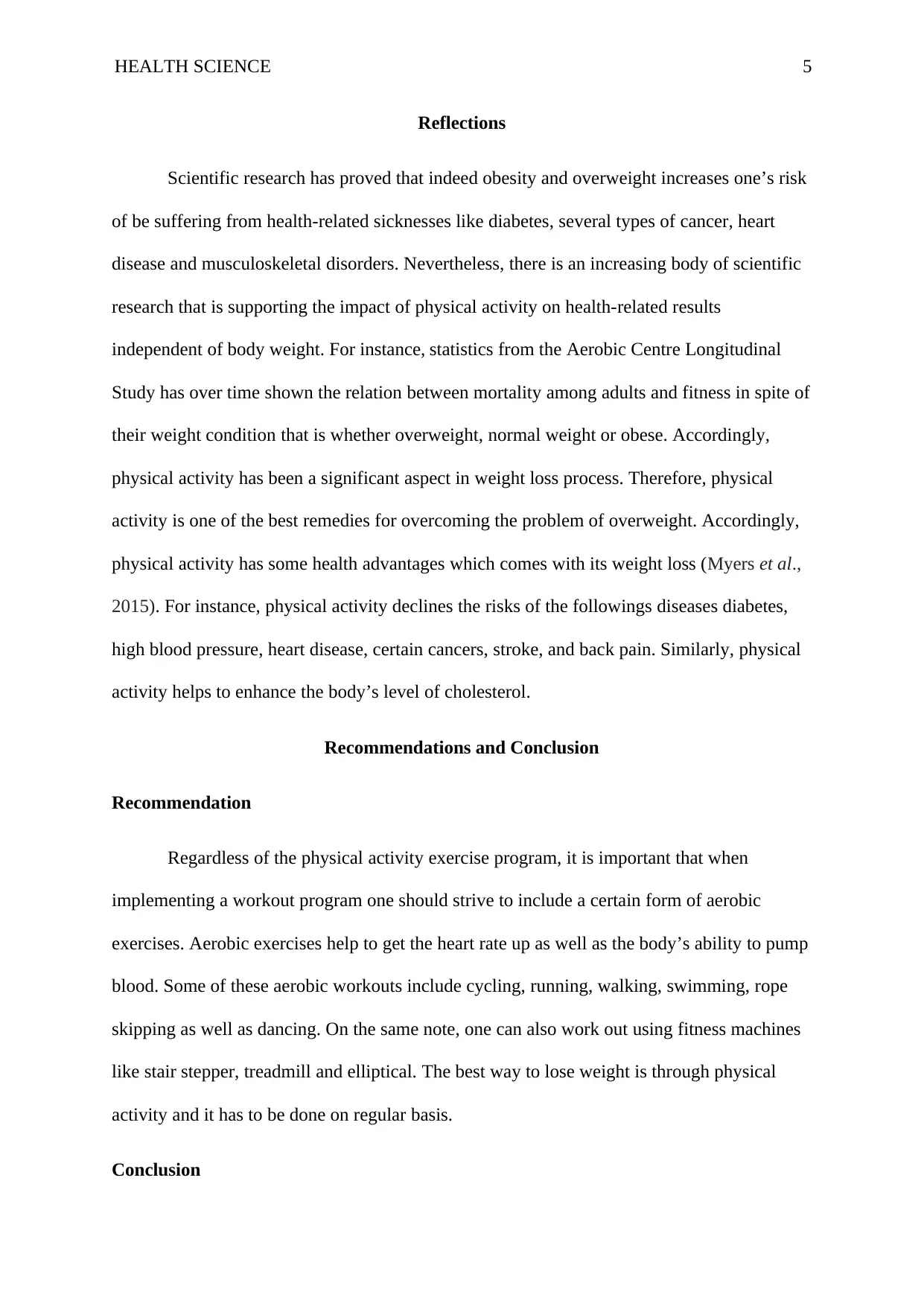
HEALTH SCIENCE 5
Reflections
Scientific research has proved that indeed obesity and overweight increases one’s risk
of be suffering from health-related sicknesses like diabetes, several types of cancer, heart
disease and musculoskeletal disorders. Nevertheless, there is an increasing body of scientific
research that is supporting the impact of physical activity on health-related results
independent of body weight. For instance, statistics from the Aerobic Centre Longitudinal
Study has over time shown the relation between mortality among adults and fitness in spite of
their weight condition that is whether overweight, normal weight or obese. Accordingly,
physical activity has been a significant aspect in weight loss process. Therefore, physical
activity is one of the best remedies for overcoming the problem of overweight. Accordingly,
physical activity has some health advantages which comes with its weight loss (Myers et al.,
2015). For instance, physical activity declines the risks of the followings diseases diabetes,
high blood pressure, heart disease, certain cancers, stroke, and back pain. Similarly, physical
activity helps to enhance the body’s level of cholesterol.
Recommendations and Conclusion
Recommendation
Regardless of the physical activity exercise program, it is important that when
implementing a workout program one should strive to include a certain form of aerobic
exercises. Aerobic exercises help to get the heart rate up as well as the body’s ability to pump
blood. Some of these aerobic workouts include cycling, running, walking, swimming, rope
skipping as well as dancing. On the same note, one can also work out using fitness machines
like stair stepper, treadmill and elliptical. The best way to lose weight is through physical
activity and it has to be done on regular basis.
Conclusion
Reflections
Scientific research has proved that indeed obesity and overweight increases one’s risk
of be suffering from health-related sicknesses like diabetes, several types of cancer, heart
disease and musculoskeletal disorders. Nevertheless, there is an increasing body of scientific
research that is supporting the impact of physical activity on health-related results
independent of body weight. For instance, statistics from the Aerobic Centre Longitudinal
Study has over time shown the relation between mortality among adults and fitness in spite of
their weight condition that is whether overweight, normal weight or obese. Accordingly,
physical activity has been a significant aspect in weight loss process. Therefore, physical
activity is one of the best remedies for overcoming the problem of overweight. Accordingly,
physical activity has some health advantages which comes with its weight loss (Myers et al.,
2015). For instance, physical activity declines the risks of the followings diseases diabetes,
high blood pressure, heart disease, certain cancers, stroke, and back pain. Similarly, physical
activity helps to enhance the body’s level of cholesterol.
Recommendations and Conclusion
Recommendation
Regardless of the physical activity exercise program, it is important that when
implementing a workout program one should strive to include a certain form of aerobic
exercises. Aerobic exercises help to get the heart rate up as well as the body’s ability to pump
blood. Some of these aerobic workouts include cycling, running, walking, swimming, rope
skipping as well as dancing. On the same note, one can also work out using fitness machines
like stair stepper, treadmill and elliptical. The best way to lose weight is through physical
activity and it has to be done on regular basis.
Conclusion
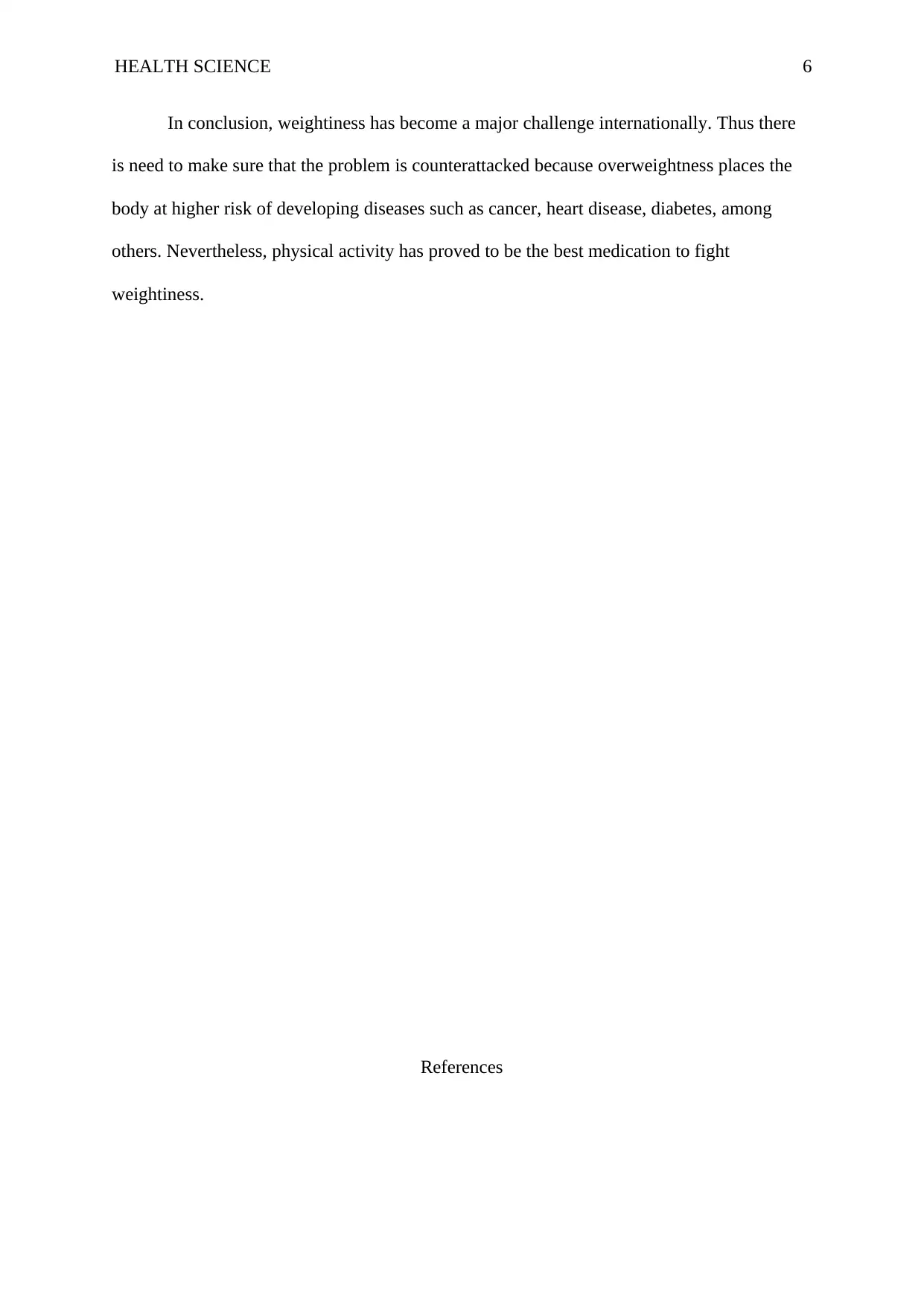
HEALTH SCIENCE 6
In conclusion, weightiness has become a major challenge internationally. Thus there
is need to make sure that the problem is counterattacked because overweightness places the
body at higher risk of developing diseases such as cancer, heart disease, diabetes, among
others. Nevertheless, physical activity has proved to be the best medication to fight
weightiness.
References
In conclusion, weightiness has become a major challenge internationally. Thus there
is need to make sure that the problem is counterattacked because overweightness places the
body at higher risk of developing diseases such as cancer, heart disease, diabetes, among
others. Nevertheless, physical activity has proved to be the best medication to fight
weightiness.
References
⊘ This is a preview!⊘
Do you want full access?
Subscribe today to unlock all pages.

Trusted by 1+ million students worldwide
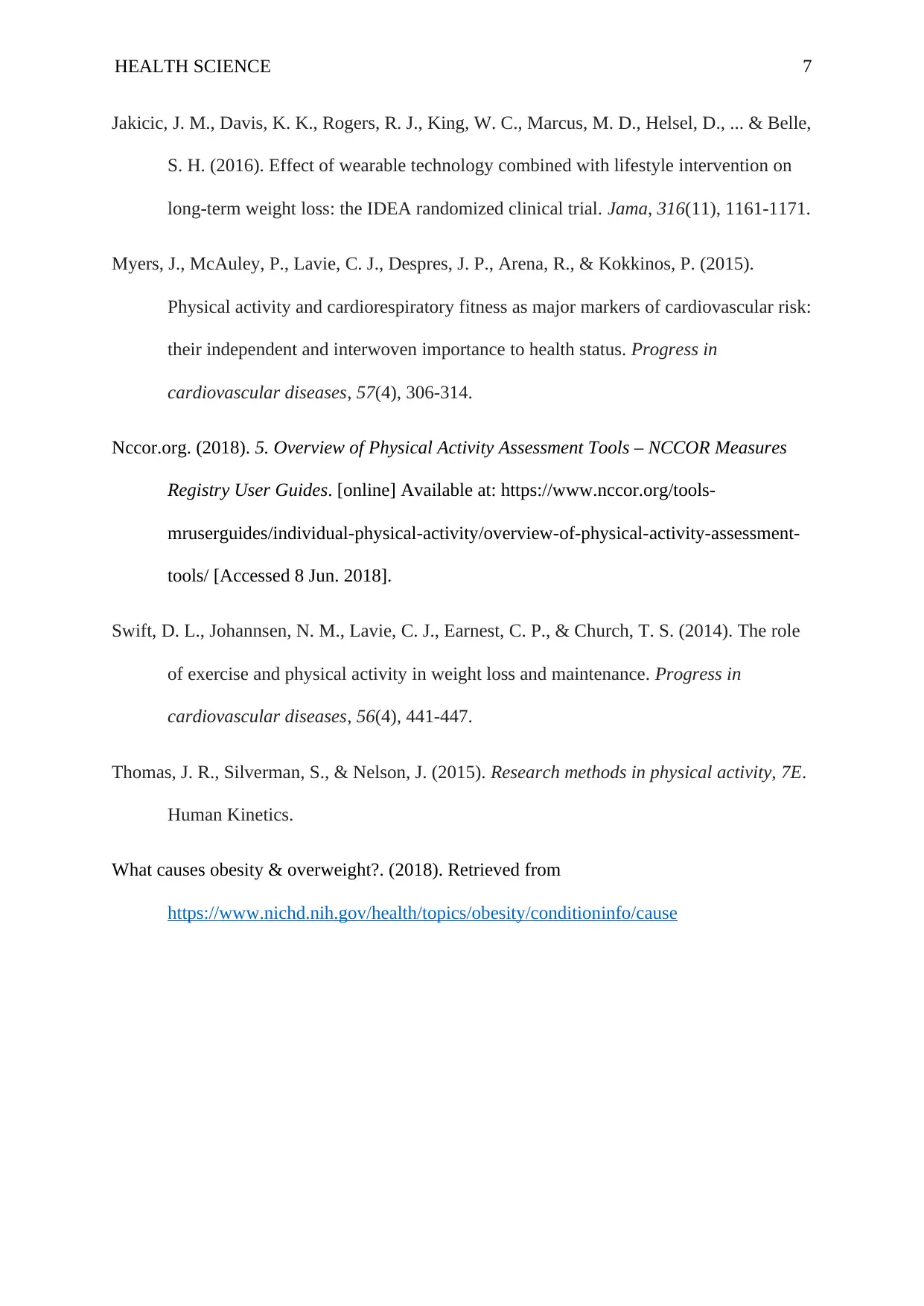
HEALTH SCIENCE 7
Jakicic, J. M., Davis, K. K., Rogers, R. J., King, W. C., Marcus, M. D., Helsel, D., ... & Belle,
S. H. (2016). Effect of wearable technology combined with lifestyle intervention on
long-term weight loss: the IDEA randomized clinical trial. Jama, 316(11), 1161-1171.
Myers, J., McAuley, P., Lavie, C. J., Despres, J. P., Arena, R., & Kokkinos, P. (2015).
Physical activity and cardiorespiratory fitness as major markers of cardiovascular risk:
their independent and interwoven importance to health status. Progress in
cardiovascular diseases, 57(4), 306-314.
Nccor.org. (2018). 5. Overview of Physical Activity Assessment Tools – NCCOR Measures
Registry User Guides. [online] Available at: https://www.nccor.org/tools-
mruserguides/individual-physical-activity/overview-of-physical-activity-assessment-
tools/ [Accessed 8 Jun. 2018].
Swift, D. L., Johannsen, N. M., Lavie, C. J., Earnest, C. P., & Church, T. S. (2014). The role
of exercise and physical activity in weight loss and maintenance. Progress in
cardiovascular diseases, 56(4), 441-447.
Thomas, J. R., Silverman, S., & Nelson, J. (2015). Research methods in physical activity, 7E.
Human Kinetics.
What causes obesity & overweight?. (2018). Retrieved from
https://www.nichd.nih.gov/health/topics/obesity/conditioninfo/cause
Jakicic, J. M., Davis, K. K., Rogers, R. J., King, W. C., Marcus, M. D., Helsel, D., ... & Belle,
S. H. (2016). Effect of wearable technology combined with lifestyle intervention on
long-term weight loss: the IDEA randomized clinical trial. Jama, 316(11), 1161-1171.
Myers, J., McAuley, P., Lavie, C. J., Despres, J. P., Arena, R., & Kokkinos, P. (2015).
Physical activity and cardiorespiratory fitness as major markers of cardiovascular risk:
their independent and interwoven importance to health status. Progress in
cardiovascular diseases, 57(4), 306-314.
Nccor.org. (2018). 5. Overview of Physical Activity Assessment Tools – NCCOR Measures
Registry User Guides. [online] Available at: https://www.nccor.org/tools-
mruserguides/individual-physical-activity/overview-of-physical-activity-assessment-
tools/ [Accessed 8 Jun. 2018].
Swift, D. L., Johannsen, N. M., Lavie, C. J., Earnest, C. P., & Church, T. S. (2014). The role
of exercise and physical activity in weight loss and maintenance. Progress in
cardiovascular diseases, 56(4), 441-447.
Thomas, J. R., Silverman, S., & Nelson, J. (2015). Research methods in physical activity, 7E.
Human Kinetics.
What causes obesity & overweight?. (2018). Retrieved from
https://www.nichd.nih.gov/health/topics/obesity/conditioninfo/cause
1 out of 7
Related Documents
Your All-in-One AI-Powered Toolkit for Academic Success.
+13062052269
info@desklib.com
Available 24*7 on WhatsApp / Email
![[object Object]](/_next/static/media/star-bottom.7253800d.svg)
Unlock your academic potential
Copyright © 2020–2025 A2Z Services. All Rights Reserved. Developed and managed by ZUCOL.





